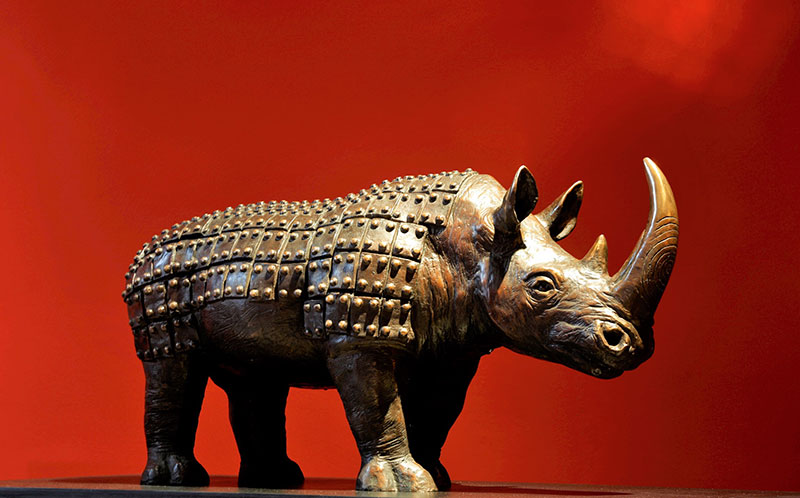
Armor Suit Rhino | 金縷犀
| 語音導覽 | 青銅 Bronze 86.5 x 35 x43cm |
《金縷衣》一詞源於中唐時期杜秋娘所作之七言絕句:「勸君莫惜金縷衣,勸君惜取少年時。」此作品嘗試將東方古典文學語彙援引入當代雕塑,作品創新大膽,靈獸犀牛身著一席鎧甲,體態輕盈矯健,令人聯想秦始皇陵陵園的兵馬陣,居於陣式正中央的重裝兵俑,是色彩最為鮮豔、最為身強力健的一支隊伍,他們身披的鎧甲均為犀牛皮甲。因古時最珍貴的鎧甲為犀牛皮製,帝王用於犒賞有功績的將領,故而為犀牛的毀滅帶來了災難性的命運。此作品著重突出犀牛角的力量感,體現了犀牛生命力的頑強與精神力量,亦帶有人性必須自檢自持的省思。
藝術家施力仁以犀牛為載體,並能通過一個題材表達多元性,反而更顯得意義之重,對生命的關切之重。品味《金縷犀》,是藝術家超越時間的企圖,是歷史的光華,是省思環保的幽默諷刺;亦是犀牛散播生命中最單純的快樂與自在。
The phrase "The Gold-Threaded Dress" has its roots in a seven-line poem by Du Qiuniang from the middle Tang Dynasty. The poem urges individuals to cherish and make the most of their youth. This sculpture aims to incorporate classical terminology from Eastern literature into contemporary art in an innovative and daring manner. The sculpture depicts a graceful and nimble rhinoceros decked in armor, reminiscent of the military formation of the Terracotta Army in Emperor Qin Shi Huang's tomb. The heavily armed infantry at the center of the formation were the most powerful and resilient troops, with armor made of rhinoceros skin, including breastplates and shoulder pads. The use of rhinoceros skin as armor in ancient times, especially by emperors to reward successful generals, ultimately resulted in the catastrophic fate of rhinoceros. This artwork accentuates the might of the rhinoceros horn, reflecting the strength and spiritual fortitude of rhinoceros life, while also encouraging self-reflection and self-control in human nature. The artist, Shih Li-Jen, utilizes the rhinoceros as a vehicle to express diversity through a single theme, thereby adding greater significance to the artwork's concern for life. Appreciating the "Armor suit Rhino" is the artist's attempt to transcend time, showcasing the grandeur of history, and humorously satirizing and reflecting on environmental conservation. It is also an opportunity to spread the most genuine joy and liberation of life through the rhinoceros.